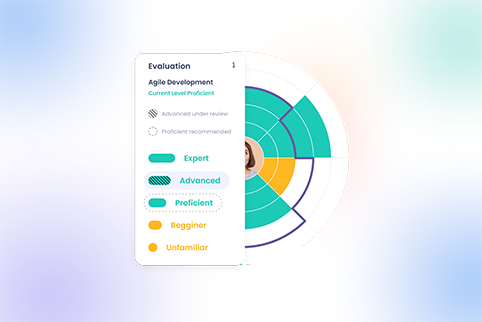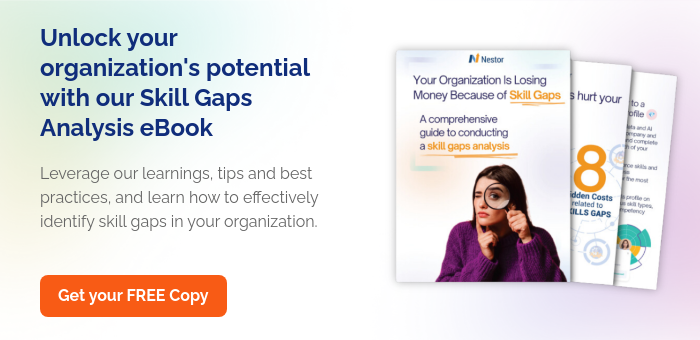How to Close the Skills Gap: Strategic Approaches to Overcome Talent Shortages
13 min read

Closing the skills gap has become a pressing concern in today’s job market, with businesses of all sizes struggling to find candidates with the right expertise to fill critical roles. This issue not only slows organizational growth but also has a significant negative impact on productivity, innovation, and competitiveness.
If skill-building doesn’t catch up with the rate of technological progress, the G20 economies could lose up to $11.5 trillion in cumulative GDP growth in the next 10 years.
— Accenture
While addressing the skills gap shouldn’t fall entirely on the shoulder of HR professionals, many will look to them for effective solutions to addressing the shortage of critical knowledge and abilities.
With this article, we aim to equip HR and business leaders with effective strategies to address the existing and upcoming skills gap in their organizations. We will delve into various actionable approaches and measures, from recruitment and training to internal mobility and collaboration with educational institutions. Let’s dive right in!
How to identify skills gaps
While organizations may experience a shortage of in-demand skills and expertise, there is certainly no shortage of methods to identify skills gaps. But let’s start with the beginning. A thorough skills-gap analysis starts with a few steps:
Establish your business objectives
Identifying the short- and long-term goals you want to achieve as an organization represents the foundation for your skills gap analysis. This process will help you decide which missing skills are a priority (and which aren’t) and will provide the necessary clarity required in the decision-making and planning stages.
Later on, these business goals will also act as pillars for employee development programs, with which you can ensure that workers develop their skills in line with the organization’s needs.
Involve your managers in the process
Your leadership and managers should be aware of the short- and long-term goals established at the beginning. This applies to all departments, from HR and Sales to Engineering and Customer Support.
And involving them in the process of defining these goals from the start will not only bring awareness and transparency but will also keep your strategic efforts aligned. Together, you’ll be able to come up with ideas and plans that address the individual (skills-gap) concerns of different departments without deviating from the bigger picture.
Define the skills required to achieve your objectives
To be able to close the skills gap, identifying the abilities and knowledge necessary to achieve your business objectives is essential. This process not only pinpoints the specific areas where gaps exist but also defines the desired competencies and proficiency levels.
For instance, suppose your goal is to boost sales in the upcoming three years. In that case, your sales teams should display high (advanced) proficiency in verbal and written communication, negotiation, and persuasion.
Conduct skills assessments
Proficiency tests or assessments are a straightforward way of evaluating the current skills of your workforce. These should take place annually or periodically, depending on your situation, because in some industries skills can become obsolete faster.
Skills assessments don’t need to be in the form of rigid evaluations. They can take the form of:
- practical tests
- performance evaluations
- open discussions with managers and team leaders
- 360 feedback
Provide employee self-assessment opportunities
By creating a culture of trust and openness, your employees will feel safe to not only talk about their strengths but also about their weaknesses or areas where they feel they have more to offer.
Compare current skills with job descriptions and competency frameworks
Comparing the skills and qualifications already present within the company with job requirements and competency frameworks will highlight any hidden or overlooked skills gaps.
This step can only succeed if job descriptions are clear and competency frameworks are already established and followed.
Stay updated on the latest industry trends
Identifying emerging skills and knowledge gaps early on will help you stay ahead of changes that may affect the company’s future. This doesn’t only apply to technological advancements, but also to regulatory changes and shifting market demands.
In the current business landscape, the adoption of generative AI solutions is perhaps the best example.
Examine feedback from customers and clients
A less common but effective method to identify (potential) skills gaps gather feedback about your company, products, and services from your target audience or business partners.
Their insights could reveal opportunities for improvements or areas where your organization can make changes to grow even further.
Look at competitors in your industry
Analyzing your competitors, as well as their skills and competencies, can help your organization identify where you are lagging behind or what you can do to be more competitive.
How to close the skills gap in your organization
After identifying the existing (and potential or future) skills gaps, it’s time to look at the best ways to bridge them.
We’re highlighting the fact that to close the skills gap, you need to make it a priority or commitment at the leadership or business level. It will require a strategic approach and careful planning.
Some companies might even choose to assemble a skills gap task force dedicated to this entire process. It can reunite employees from various departments — including L&D, talent acquisition, department leaders, or people managers — and should meet regularly to evaluate progress and make decisions.
With that in mind, let’s look at some actual steps to close the skills gap in your organization:
1. Develop a strategic upskilling/reskilling plan
It’s difficult to align organizational goals and the development of your employees without a strategic plan. It should be based on the initial findings from the skills gap analysis phase and focus on the best-fit upskilling and reskilling initiatives for your workforce.
By understanding both the present and future direction of the organization, it should be easier to anticipate changes in the skills landscape and develop proactive strategies to prevent skills gaps from occurring in the first place.
This strategic plan should also take into account both internal factors, like skills matrices, training, or succession planning, and external ones, like industry trends or market demands.
2. Create a culture of continuous learning
Not all skills gaps will benefit the same way from a company culture that encourages continuous learning, but soft and digital skills certainly will.
Their development might anyway happen in the flow of work (also called on-the-job learning), but with the necessary support and encouragement, it can become a regular initiative instead of an accidental one.
The benefits of this type of culture can often show up during the skills gap analysis, when organizations may realize they aren’t fully aware of the full skill set possessed by their people.
3. Invest in employee training and development
To close the skills gap, learning, training, and development opportunities are a must. And one of the best ways to ensure they bring the right results is to provide targeted programs, which match the specific needs of each employee.
These opportunities can be either formal and informal, and organized internally or with the help of third parties. They will bring results as long as they’re aligned with each individual’s needs and potential and with the organizational goals.
Training or development can take various forms, including:
- job shadowing
- knowledge-sharing sessions
- mentorship
- workshops
- online courses
- seminars
- job swapping
4. Embrace experiential learning through internal mobility practices
According to statistics, most learning occurs beyond formal training programs. It is in fact a continuous learning process where people get to develop their skills through on-the-job experiences, the so-called experiential learning. This process of learning on the go occurs mostly when employees have the opportunities to participate in various projects inside the organization, in cross-functional teams, or to move vertically or laterally to other roles. And few things will facilitate internal mobility more than a talent marketplace.
This talent marketplace is a one-stop platform where all opportunities for growth, development, and professional advancement are transparent and easily accessible to all your employees.
Not only does this approach democratize career development but it also creates a more dynamic and fulfilled workforce, improving employee retention in the process.
Learn more about Nestor’s talent and opportunity marketplace.
5. Monitor and evaluate skills development regularly
Should your organization choose to assemble a skills gap task force, these would be some of their main responsibilities: to assess the current states of skills and proficiency levels as well as their development over time.
This evaluation also needs to look at the effectiveness of training and development programs and provide insights on what works and what doesn’t, so that data-driven adjustments can be made in time.
Factors you want to look at during this process include:
- employees progress towards their development goals (e.g., upskilling, reskilling)
- employees’ satisfaction with current growth opportunities
- the dynamic of the skills gap within the company (narrowing vs widening)
Performing skills-gap analyses regularly should become a business imperative because they represent an opportunity to greatly reduce future skills gaps.
6. Adopt emerging technologies and innovations early on
There are two main reasons why we recommend the early adoption of the latest tech and trends:
- Leveraging digital tools, such as skills management platforms, learning management systems, virtual training modules, and online collaboration tools can significantly enhance the training and development efforts of your company.
- Fast adoption of innovative tools, like simulations or virtual reality, will help your workforce build the skills they need quicker and respond easier to new business needs, improving overall business performance and competitiveness.
7. Improve recruitment practices
With a more targeted recruitment process, HR can help close the skills gap in your organization. To achieve this, there should be a shift in the selection of candidates: from certifications and diplomas to real-life skills backed by experience and achievements.
The expected or targeted skills should be clearly outlined when crafting job advertisements and more focus should be placed on examining not only the current skills of candidates but also their potential and desire to grow and keep on learning.
Another approach, with a more short-term focus, would be to hire temporary or contract workers. This can be both an advantage and a disadvantage. But as far as closing the skills gap is concerned, in some situations, external hires might be the only solution.
You can also make the most out of their expertise by including them in training initiatives, which will help the rest of your workforce expand their skillset.
8. Collaborate with educational institutions
Collaborations between businesses and educational institutions are nothing new. From internships to workshops, many companies are looking at smart ways to recruit and prepare top talent early on.
But an even more impactful initiative would be to allow businesses, with governmental approval, to help shape curriculum in various universities, colleges, or vocational schools — with the clear end goal of aligning the education of future workers with industry needs.
This type of initiative may not always be easy to implement, but it can yield positive results and reduce the resources (time, money) that organizations need to invest in graduates who lack the real-life skills expected in the modern workplace.
Examples of common skills gaps
While the mismatch between the skills of employees and the required competencies can vary significantly across companies and industries, certain areas have emerged where these gaps are more common:
Digital skills gaps
Given the rapidly evolving technological landscape, it’s hardly surprising that workers are struggling to keep their digital skills up-to-date.
And as the process of digitalization continues to advance and shape more and more industries, the demand for people who can effectively use digital tools and platforms will only increase – further widening the gap between business needs and employees’ skills.
To address digital skills gaps, which aren’t as easy to pick up as soft skills, for example, companies need to invest in targeted training and upskilling initiatives.
Common digital skills gaps include:
- Artificial Intelligence (AI): leveraging AI tools and machine learning to automate repetitive tasks and focus on more important projects.
- Cloud computing: collaborating across different online platforms is already an essential aspect of the modern workplace, not only for remote companies.
- Cyber security: being able to identify fishing emails and protect sensitive information, like log-in credentials, will become more important than ever.
- Data analyzing: collecting, sorting, and extracting relevant and actionable insights from data is now an essential stage in the decision-making process.
- Social media marketing: from promoting products and services to engaging with customers and maintaining a brand image – few companies (if any) we’ll be able to ignore the importance of being present in the digital landscape.
Soft skills gaps
Gaps related to interpersonal or soft skills shouldn’t be overlooked. They can have a huge impact on how your managers and teams collaborate, communicate, and work together. And this, in turn, determines how productive and impactful the organization really is.
The advantage is that while they can be developed with specific training and learning opportunities, soft skills can also be improved very easily by fostering a supportive and inclusive work environment.
Common soft skills gaps include:
- Problem-solving: rather a combination of other abilities, problem-solving empowers employees to analyze complex issues, think critically, and come up with creative solutions.
- Teamwork or collaboration: while different people have different styles or preferences when it comes to work (e.g., extroverts vs introverts), not being able to work together with others and being efficient as a team is a significant disadvantage.
- Communication: either verbal or written, the ability to express ideas clearly and adapt to different audiences is critical in the modern world of work.
- Leadership: given its importance, perhaps it deserves to be a category on its own. In any case, leadership skills, such as the ability to inspire, motivate, and drive teams are immensely valuable in any organization.
Hard skills gaps
Depending on how you look at things, hard skills (or at least some of them) overlap to a certain extent with (some) digital skills. They can be improved through specialized training and certifications but also through on-the-job learning, if the company culture embraces continuous learning.
Common hard skills gaps include:
- Automotive servicing: evaluating, servicing, and testing various vehicles to ensure they are safe and ready to be used.
- Foreign languages: in many industries or professions, employees can stand out by mastering at least 2 or 3 languages.
- Graphic design & video editing: since more and more companies need to be present online, they require high-quality design, logos, and videos to promote their brand and services.
- Programming: expertise in multiple programming languages is a highly sought-after skill.
- SEO: to reach target audiences and drive business opportunities, companies need to optimize their content in order to rank higher in search engine results.
How Nestor can help identify and close the skills gap in your organization
Nestor is a People Intelligence Platform designed from the ground up to unlock the Power of Skills. We help organizations achieve workforce agility, high performance, and continuous growth.
The tools and modules on our platform — from Dynamic Skills Taxonomies, Pulse Surveys, and Performance Reviews to the Talent Marketplace, Predictive Analytics, and Smart Dashboards — will not only help you close the skills gap but also future-proof your workforce. With Nestor, you will:
- identify evolving skill needs
- track and evaluate skill levels
- match skill supply and demand
- develop and grow both organizational and people capabilities
- enable internal mobility and talent optimization
Together, we’ll unleash the full potential of your talented workforce. If you want to learn more about how Nestor can help you, schedule a free demo session.








